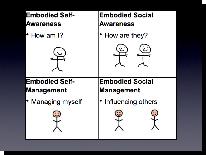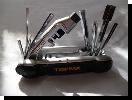
Ethics
- Power and love embodied
- Service intention
Personal embodied presence
- Health – this is the foundation.
- Short term – state – and long term disposition and embodiment – as a result of thousands of hours of practice. Far more important than tools and tricks is WHO WE ARE and how we are.
- Personal qualities across all four elements (see handout). A range of skills and virtues are needed.
- 4 aspects of embodied intelligence all developed – awareness, management, empathy and influence.
- Yin and yang range – both are needed for facilitation.
- A developed sense of rhythm (see 4 seasons model and cycles hand-out). Timing and flow is everything.
An adequate tool-kit
- Good depth and breadth with the 8 embodied tools:
 Awareness
Awareness- Acceptance
- Intention
- Imagery
- Posture
- Relaxation
- Movement
- Responsiveness
- Yang and yin tools – E.g challenge and support, direct feedback and curiosity
- Fundamentals of the trade (e.g. ICF core coaching competencies – PTO)
- Other relevant professional skills, e.g. sales, marketing and financial skills
Reflection Questions:
– What is the strength and risk of your strongest element as a facilitator?
– How does your yin-yang preference show up as a facilitator?
– How would you rate yourself on the four quadrant model of embodied intelligence now?
– How does your season preference show up as a facilitator?
– Which is your strongest and weakest tool of the 8 tools?
– What other professional skills do you need to develop to be a better embodied facilitator? E.g. marketing.
Appendix – International Coach Federation Core Competencies
A. Setting the Foundation
1. Meeting Ethical Guidelines and Professional Standards
2. Establishing the Coaching Agreement
B. Co-creating the Relationship
3. Establishing Trust and Intimacy with the Client
4. Coaching Presence
C. Communicating Effectively
5. Active Listening
6. Powerful Questioning
7. Direct Communication
D. Facilitating Learning and Results
8. Creating Awareness
9. Designing Actions
10. Planning and Goal Setting
11. Managing Progress and Accountability
Watch Integration Training videos:
6 Directions of live and leadership embodiment
For information on Integration Training Courses click here